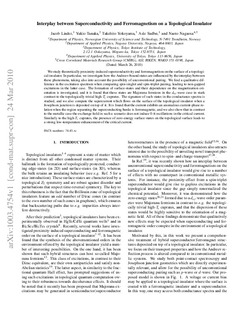Interplay between superconductivity and ferromagnetism on a topological insulator
Journal article, Peer reviewed
Accepted version
Permanent lenke
http://hdl.handle.net/11250/2455002Utgivelsesdato
2010Metadata
Vis full innførselSamlinger
- Institutt for fysikk [2686]
- Publikasjoner fra CRIStin - NTNU [38062]
Originalversjon
Physical Review B. Condensed Matter and Materials Physics. 2010, 81 (18), . 10.1103/PhysRevB.81.184525Sammendrag
We study theoretically proximity-induced superconductivity and ferromagnetism on the surface of a topological insulator. In particular, we investigate how the Andreev-bound states are influenced by the interplay between these phenomena, taking also into account the possibility of unconventional pairing. We find a qualitative difference in the excitation spectrum when comparing spin-singlet and spin-triplet pairing, leading to nongapped excitations in the latter case. The formation of surface states and their dependence on the magnetization orientation is investigated, and it is found that these states are Majorana fermions in the dxy-wave case in stark contrast to the topologically trivial high-Tc cuprates. The signature of such states in the conductance spectra is studied, and we also compute the supercurrent which flows on the surface of the topological insulator when a Josephson junction is deposited on top of it. It is found that the current exhibits an anomalous current-phase relation when the region separating the superconducting banks is ferromagnetic, and we also show that in contrast to the metallic case the exchange field in such a scenario does not induce 0-π oscillations in the critical current. Similarly to the high-Tc cuprates, the presence of zero-energy surface states on the topological surface leads to a strong low-temperature enhancement of the critical current.
